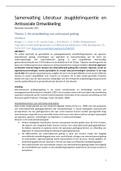Samenvatting
Summary of statistics for the pre-master
- Vak
- Instelling
- Boek
This is a summary of the lectures and book of the statistic course during the pre-master communication and information science at Tilburg University. It covers the chapters of the book 'Discovering statistics using IBM SPSS Statistics' by Andy Field, supplemented with the teaching material that was...
[Meer zien]













